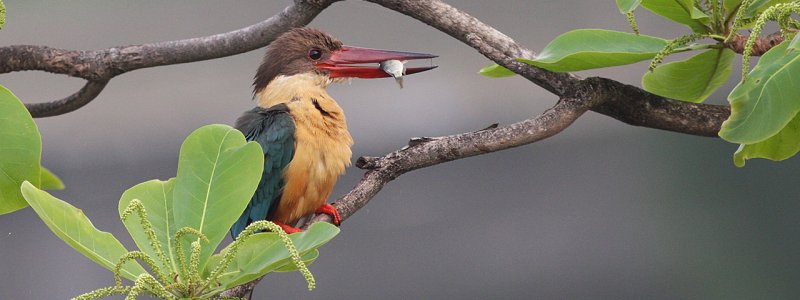Birds & Wildlife at the Hermitage
Now that the gardens are growing up after the monsoon, the bird life is slowly increasing and this will continue in the future as we plant more of those trees and shrubs that attract our feathered friends.
Early morning by the beach is the best place to see them. Kites ride the thermals in wide, lazy circles or gather in numbers on the sand; smaller than them is the elegant Brahminy Kite with its white head and chest and russet wings. Grey-headed Eagles and Fishing Eagles are common, and there is a pair of snake-eating White-bellied Sea Eagles nesting just north of our lagoon, one of only 38 pairs known in Kerala. Black, long-necked Little Cormorants perch on trees, hanging out their wings to dry in the sun.
Various Waders pick their way fastidiously through the water, while white Little Eagrets and the larger Great Eagrets can often be spotted, usually on the far side of the lagoon, their favourite fishing place. Pretty green and golden Bee Eaters with their long spike of a tail, and their cousins the Blue Tailed Bee Eater, play in the trees around the lagoon, while Sandpipers, Green and Red Shanks (named after the colour of their legs), White-breasted Kingfishers with long beak, blue back and orange wings, and the larger black-and–white Pied Kingfishers are all often seen.
In the gardens, keep a look out for the small, purple-rumped Sunbirds, rather like humming birds with long nectar-drinking bills that can be sighted feeding at the top of coconut palms. An elegant Pond Heron, with white and brown streaked throat, grey-mushroom back and white under wings, is very often seen stepping fastidiously around the lawns in search of insect prey, while the brilliant Flameback Woodpeckers can be seen climbing the trees in the early evening, usually in pairs.
About the size of a large starling they have a small bright red crest, speckled black and white head and breast and reddish-saffron wings. Their call is loud and startling. Keep your eyes open too for the dignified Coucal (often called the Pheasant Crow) blue-black with russet wings and a long tail, that usually steps elegantly along the ground or hops among the lower branches of bushes or small trees. Sometimes seen in twos or threes (locals believe a sighting brings good luck) their call is a very distinctive series of hoop-hoop-hoop-hoop-hoop-hoop-hoop cries, descending and then rising towards the end.
Malabar is very rich in bird life, having over 340 species. One bird not yet reported here is the Prescient Parakeet. ‘Parrot Astrologers’ are roadside fortune-tellers who read your future with the help of a tame green parakeet. The bird picks up a card from a special deck of tarot-like cards, and gives it to the astrologer who interprets it according to the questions that you ask. This fairground skill, now confined to Tamil Nadu and Kerala, dates back to ancient India, and a version of it was practised until fairly recently by the Romanies in Europe. These people were originally low caste nomadic tribes from Rajasthan who, on their way to Europe, stayed a long time in Egypt, hence their common English name ‘gypsies’.
However, perhaps mindful of their origins, they prefer to call themselves didicoits, a name derived from a Rajasthani dialect word meaning ‘traveller’. Binoculars and bird books are available to use at Meenakshi, and our life-guard Prasanth will also help you to spot some of these birds. A trip up the lagoon in our canoe will reveal many more species too shy to come out into the open.










